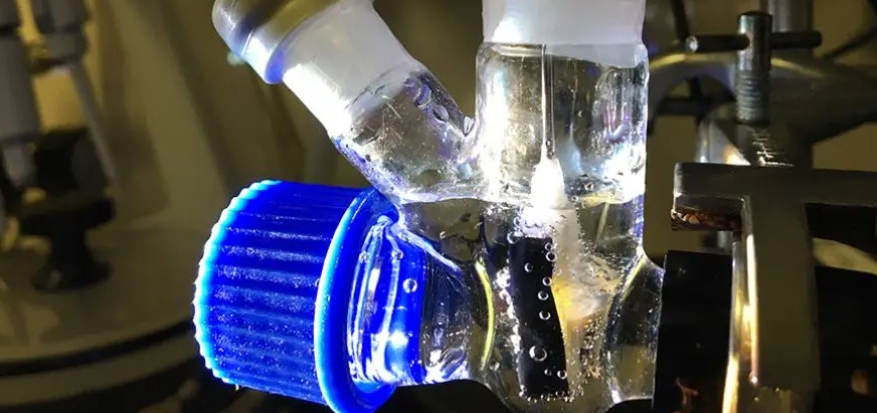Driving on sunshine: clean, usable liquid fuels made from solar power
剑桥大学的研究人员研发了一种太阳能技术,可将二氧化碳和水转化成液体燃料,直接加注到汽车引擎中使用。
Researchers have developed a solar-powered technology that converts carbon dioxide and water into liquid fuels that can be added directly to a car’s engine as drop-in fuel.
剑桥大学研究人员利用光合作用将二氧化碳、水和阳光转化为多碳燃料——乙醇和丙醇。这些燃料具有高能量密度,易于储存或运输。
The researchers, from the University of Cambridge, harnessed the power of photosynthesis to convert CO2, water and sunlight into multicarbon fuels – ethanol and propanol – in a single step. These fuels have a high energy density and can be easily stored or transported.
与化石燃料不同,这些太阳能燃料产生净零碳排放并且是完全可再生的。同时,与大多数生物乙醇不同,它们不会占用任何农业用地用于粮食生产。
Unlike fossil fuels, these solar fuels produce net-zero carbon emissions and are completely renewable, and unlike most bioethanol, they do not divert any agricultural land away from food production.

在太阳照射下工作的带有“人造树叶”的光反应器
A photoreactor with an artificial leaf working under solar irradiation.
虽然这项技术仍处于实验室规模,但研究人员表示,他们的“人造树叶”是从以化石燃料为基础的经济转型的重要一步。该成果发表在《自然能源》杂志上。
While the technology is still at laboratory scale, the researchers say their ‘artificial leaves’ are an important step in the transition away from a fossil fuel-based economy. The results are reported in the journal Nature Energy.
生物乙醇被形容是更清洁的汽油替代品,因为它是由植物而不是化石燃料制成的。今天路上行驶的大多数汽车和卡车都使用乙醇含量高达 10% 的汽油(E10 燃料)。美国是世界上最大的生物乙醇生产国:根据美国农业部的数据,美国种植的所有玉米中近 45% 用于乙醇生产。
Bioethanol is touted as a cleaner alternative to petrol, since it is made from plants instead of fossil fuels. Most cars and trucks on the road today run on petrol containing up to 10% ethanol (E10 fuel). The United States is the world’s largest bioethanol producer: according to the U.S. Department of Agriculture, almost 45% of all corn grown in the US is used for ethanol production.
“像乙醇这样的生物燃料是一项有争议的技术,尤其是因为它们占用了本可以用来种植粮食的农业用地,”领导这项研究的Erwin Reisner教授说。
“Biofuels like ethanol are a controversial technology, not least because they take up agricultural land that could be used to grow food instead,” said Professor Erwin Reisner, who led the research.
几年来,Reisner位于化学系的研究小组一直在开发可持续的零碳燃料,其灵感来自光合作用——植物将阳光转化为食物的过程——使用人造树叶。
For several years, Reisner’s research group, based in the Yusuf Hamied Department of Chemistry, has been developing sustainable, zero-carbon fuels inspired by photosynthesis – the process by which plants convert sunlight into food – using artificial leaves.
迄今为止,这些人造树叶只能制造简单的化学物质,例如合成气,一种氢气和一氧化碳的混合物,用于生产燃料、药物、塑料和肥料。但为了使这项技术更加实用,它需要能够在单个太阳能步骤中直接生产更复杂的化学品。
To date, these artificial leaves have only been able to make simple chemicals, such as syngas, a mixture of hydrogen and carbon monoxide that is used to produce fuels, pharmaceuticals, plastics and fertilisers. But to make the technology more practical, it would need to be able to produce more complex chemicals directly in a single solar-powered step.
现在,人造树叶可以直接生产清洁的乙醇和丙醇,不需要中间生产合成气的步骤。
Now, the artificial leaf can directly produce clean ethanol and propanol without the need for the intermediary step of producing syngas.
研究人员开发了一种铜和钯基催化剂。催化剂经过优化,使人造叶子能够产生更复杂的化学物质,特别是多碳醇乙醇和正丙醇。这两种醇都是高能量密度燃料,易于运输和储存。
The researchers developed a copper and palladium-based catalyst. The catalyst was optimised in a way that allowed the artificial leaf to produce more complex chemicals, specifically the multicarbon alcohols ethanol and n-propanol. Both alcohols are high energy density fuels that can be easily transported and stored.
研究人员开发了一种铜和钯基催化剂。催化剂经过优化,使人造叶子能够产生更复杂的化学物质,特别是多碳醇乙醇和正丙醇。这两种醇都是高能量密度燃料,易于运输和储存。
The researchers developed a copper and palladium-based catalyst. The catalyst was optimised in a way that allowed the artificial leaf to produce more complex chemicals, specifically the multicarbon alcohols ethanol and n-propanol. Both alcohols are high energy density fuels that can be easily transported and stored.
其他科学家已经能够使用电力生产类似的化学物质,但这是第一次仅使用来自太阳的能量用人造树叶生产如此复杂的化学物质。
Other scientists have been able to produce similar chemicals using electrical power, but this is the first time that such complex chemicals have been produced with an artificial leaf using only the energy from the Sun.
该论文的第一作者Motiar Rahaman博士说:“将阳光照射在人造树叶上,并从二氧化碳和水中获取液体燃料是一种惊人的化学反应。”
“Shining sunlight on the artificial leaves and getting liquid fuel from carbon dioxide and water is an amazing bit of chemistry,” said Dr Motiar Rahaman, the paper’s first author.
“通常情况下,当你尝试使用人造树叶装置将 CO2 转化为另一种化学产品时,你几乎总是会得到一氧化碳或合成气,但在这里,我们已经能够仅利用太阳能生产出实用的液体燃料。这是一个令人兴奋的进步,为我们的工作开辟了全新的途径。”
“Normally, when you try to convert CO2 into another chemical product using an artificial leaf device, you almost always get carbon monoxide or syngas, but here, we’ve been able to produce a practical liquid fuel just using the power of the Sun. It’s an exciting advance that opens up whole new avenues in our work.”
目前,该设备只是一个概念验证,效率不高。研究人员正在努力优化光吸收剂,使它们能够更好地吸收阳光,并优化催化剂,使其能够将更多的阳光转化为燃料。目前还需要进一步的工作来使该设备具有可扩展性,以便可以生产大量燃料。
At present, the device is a proof of concept and shows only modest efficiency. The researchers are working to optimise the light absorbers so that they can better absorb sunlight and optimising the catalyst so it can convert more sunlight into fuel. Further work will also be required to make the device scalable so that it can produce large volumes of fuel.
“尽管仍有工作要做,但我们已经展示了这些人造树叶的能力,”Reisner说, “重要的是要表明我们可以超越最简单的分子,并在我们从化石燃料过渡时制造出直接有用的东西。”
“Even though there’s still work to be done, we’ve shown what these artificial leaves are capable of doing,” said Reisner. “It’s important to show that we can go beyond the simplest molecules and make things that are directly useful as we transition away from fossil fuels.”
该研究得到了欧盟委员会 Marie Skłodowska-Curie 奖学金、剑桥信托基金和 Winton 可持续发展物理学计划的部分支持。Erwin Reisner 是剑桥大学圣约翰学院的研究员,Motiar Rahaman 是研究助理。
The research was supported in part by the European Commission Marie Skłodowska-Curie Fellowship, the Cambridge Trust, and the Winton Programme for the Physics of Sustainability. Erwin Reisner is a Fellow and Motiar Rahaman is a Research Associate of St John’s College, Cambridge.

 中文
中文 English
English
